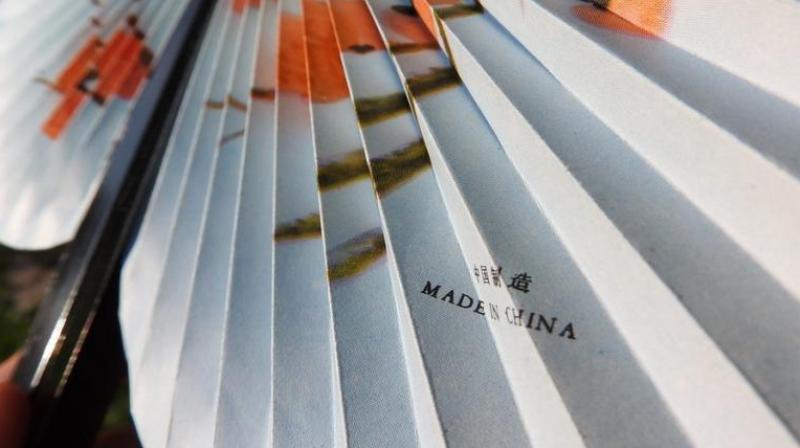Shed this phobia over Made in China'

The “Made-in-China” phobia that has come to affect some Indians is both a cause of concern and amusement. It is a cause of concern as the campaign to boycott Chinese goods has the potential to vitiate the atmosphere to the extent of Chinese manufacturers shying away from heeding Prime Minister Narendra Modi’s “Make-in-India” call and give up the idea of setting up shop in India. And it is amusing as India, according to official Chinese figures, accounts for only two per cent of total exports by China, that by the way is the world’s largest goods trading nation. Its total exports in 2015 were $2276.5 billion. Therefore, if some Indians stop buying Chinese toys, ribbons, fairy lights or pyrotechnics, China is not going to be affected, economically or politically, a point Beijing has been trying to emphasise in the past few weeks.
One would assume that the movement for boycott of Chinese goods is actually symbolic, rather than a serious attempt at hurting China’s economy. Those who are pushing the boycott are obviously motivated by their desire to teach Beijing a lesson for its refusal to back New Delhi’s case for declaring Jaish-e-Mohammed chief Masood Azhar a UN-designated terrorist, and for “blocking” India’s entry into the Nuclear Suppliers Group (NSG). Such people may be fired up by the spirit of nationalism, which is fine, but letting someone cross the line and veer towards jingoism can cause problems. It is all right if the Prime Minister has decided not to comment on the issue, but his government needs to clarify New Delhi’s position on the matter. Of course, minister of state for commerce and industry Nirmala Sitharaman made a highly sensible remark, saying “a complete ban on Chinese products demanded by sections of Indians is not feasible”.
She, however, said it was possible to introduce anti-dumping duties and safeguard mechanisms on certain products to protect producers and consumers based on evidence. Her bid to clear the air has come a little too late and enough damage has already been done as far as the investment climate is concerned. Can India afford to lose sight of the broad picture while letting some people heighten anti-China sentiments? Pakistan could be China’s all-weather friend, but New Delhi, despite the long-standing border dispute and other contentious issues, is trying to keep differences aside and forge ahead in reducing the legendary trust deficit between the two nations and build a good working relationship. In fact, trade is seen as a dominant tool that can call the shots to keep the differences away, even reduce them, and bind the two great economies. New Delhi’s challenges are immense as a look at some of these figures would suggest: trade between India and China declined from over $72 billion in 2014-15 to $70.7 billion in 2015-16, and India’s trade deficit with China rose to $52.68 billion from $48.48 billion in 2014-15. The trade deficit with China is almost half of India’s total trade deficit.
Efforts to reverse the trend are visible. For instance, even as the boycott call was becoming shriller, Ms Sitharaman held “intense” bilateral negotiations with her Chinese counterpart. She pushed China to allow Indian IT and pharma companies to access Chinese markets, which she stressed can go a long way in addressing the trade imbalance between the two Asian giants. The Chinese are actually interested in generic drugs from Indian producers but are continuing with conditions that make it tough for Indian firms to operate there. Indian pharma firms have been recognised by the US FDA and the EU, but the Chinese have as yet not given them the green signal. This discourse leads us to the question on whether India has the necessary bargaining power. China in 2015-16 accounted for only 19.3 per cent of India’s imports, but India’s exports to China was a paltry 3.6 per cent in that period. If we are to look at the current so-called “ban” on Chinese products, it is mainly on items that are most visible — crackers, kite strings, toys, ribbons, etc. These items are, however, way down in the list of products India imports from China. The import items from China that top the list includes nuclear reactors, telecommunication equipment, electrical machinery, plastics, organic chemicals, iron and steel, optical apparatus, fertilisers, inorganic chemicals, vehicles other than railway rolling stock, and boats and ships.
Recently, an India-China business meeting was held in the eastern Chinese city of Huzhou, near Shanghai. At that event, India was represented by several Shanghai-based companies which called for the flow of Chinese investment to the Prime Minister’s “Make in India” initiative. But a cursory look at Huzhou’s trade with India presents a picture of the imbalance in overall trade between the two countries. In 2015, Huzhou’s trade with India was around $370 million, while its imports from India was around $37.81 million. Therefore, there is a lesson to be learnt — of keeping the broad picture in mind while dealing with contentious issues. All eyes will now be on the meeting that is coming up in a few days between national security adviser Ajit Doval and his Chinese counterpart Yang Jiechi. New Delhi would like to achieve a breakthrough in enlisting Beijing’s support for India’s bid to join the NSG, something that is not impossible. India would also try and convince China to lend its weight on the plea to get JeM commander Masood Azhar declared a terrorist by the UN. If New Delhi manages to get Beijing’s support on either of these two sensitive issues, the case for the boycott of Chinese goods would certainly weaken. As Indians, we should leave foreign policy to our government and to members of our diplomatic corps. One has no doubt they would have the national interest foremost in their minds.

